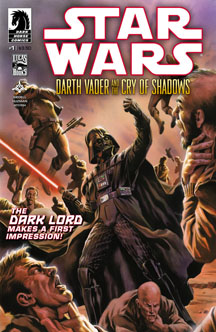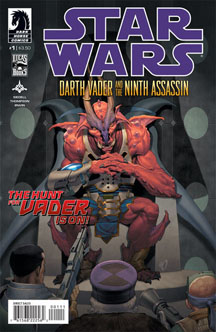After writing the first two “Darth Vader” series, veteran “Star Wars” scribe Haden Blackman handed the reins to Tim Siedell for the final two entries. These two five-issue series follow the formula of the second Blackman entry, “Darth Vader and the Ghost Prison.” Rather than showing us Vader’s thoughts, we instead see Vader cut a hellishly violent swatch across the galaxy in the wake of “Revenge of the Sith,” telling his enemies things like “I AM justice!” before cutting them down.
While I wouldn’t recommend reading more than a couple “Darth Vader” series in one sitting, there is something grimly enticing about these yarns, and Siedell – despite being a newcomer to both comics and “Star Wars” – delivers them with a steady hand.
Despite the title, “Darth Vader and the Ninth Assassin” (2013) is really about a single anonymous assassin who dons a mask similar to Vader’s. The previous eight failed assassination attempts happened off-panel. Actually, the nameless assassin just stalks Vader, trying to catch him unaware. When Vader spots him in the last issue, it’s all over.
Before that, Vader investigates an ancient superlaser being guarded by chaos worshipers (he grants them the chaos they desire by destroying their world) and ultimately steals a focusing crystal from the weapon. So we can add that crystal to the 1,000 other elements that go into the construction of the first Death Star and its superlaser in Legends canon. But the Disney canon will probably simplify the superlaser tale in a future “Rebels” arc, perhaps using the giant Kyber Crystal from the unfinished “Crystal Crisis on Utapau” arc of “The Clone Wars” as the focusing crystal.
In the end, we learn that the Emperor staged all the events as a test for Vader, but the twist isn’t really earned. The rich businessman who desires revenge for Vader killing his son is broadly sympathetic, but beyond that, a reader won’t connect with any of the characters in “Ninth Assassin.”

Siedel’s next effort, “Darth Vader and the Cry of Shadows” (2013-14), is a nice step up. We follow clone trooper Hock Malsuum through the emotionally driven development of his political views. Left for dead on a battlefield during the Clone Wars, Hock understandably loathes the Jedi.
While some clones – like family man Cut Lawquane from “Clone Wars” Season 2 – are able to leave the army and carve out a life, Hock is not good at being alone. He desires the camaraderie of his fellow troopers. Conveniently for him, Darth Vader hates the Jedi as much as he does, and the Republic army has morphed into the Imperial army, so he can join up again. A bit slow on the uptake, Hock serves at Vader’s side until he sees the dark lord mow down a village of backwater folks, including children, who just want to be left alone. At that point, he suspects Vader might be evil.

“Cry of Shadows” has good messages: The enemy of your enemy is not necessarily your friend, because there are more than two ways of looking at things. And if you have to go against an ideal in order to achieve an ideal (for example, the Empire aiming for peace via violence), it’s probably not worth doing.
As with Blackman’s “Darth Vader” titles, Siedel’s are set soon after “Episode III,” so we see the evolution of the Empire’s armaments, with Vader flying a V-wing and the troopers still wearing clone trooper armor rather than stormtrooper armor.
Still, the Empire has begun to tiptoe into the era of using enlistees instead of clones, and Hock already sees it’s a disastrous decision. He foresees the stormtroopers that we’ll see 14 years later in “Rebels” when he thinks:
“Just a few replacements. That’s all it took to undermine the infrastructure. … Lifelong training. Purpose. Replaced by those merely seeking a job. I envisioned an army of troopers who couldn’t hit anything they shot at.”
Early scuttlebutt says Marvel is doing a nice job getting into the Sith lord’s psyche in its new “Darth Vader” series set between Episodes IV and V. Among Dark Horse’s “Vader” titles, only “Darth Vader and the Lost Command” gives us a substantial window into Vader’s mind. The other three entries merely show us why we should fear him. Still, that’s an important background to have before getting into his head.

